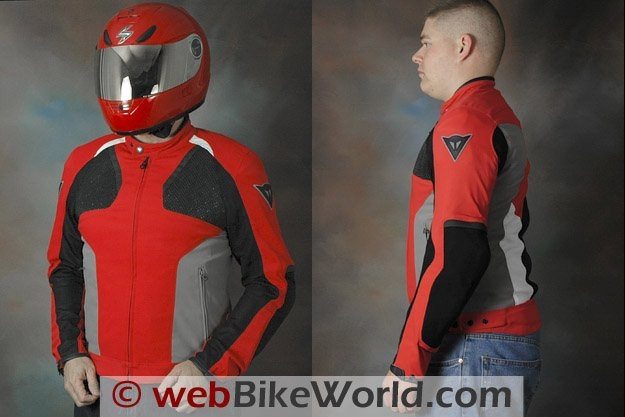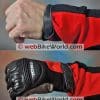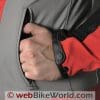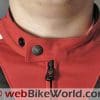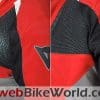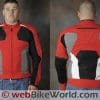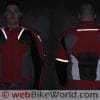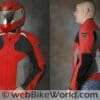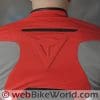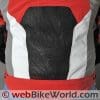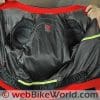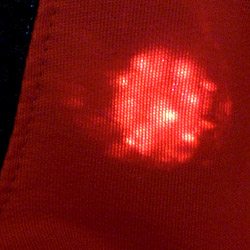Outstanding air flow, great looks, super-comfy stretch fabric and Dainese quality make this a current favorite for riding during the global heat-up of 2010. Ask your favorite search engine for a report on “July 2010 record temperatures” or “world temperatures July 2010” or the like and you’ll find results that will be similar to this report in The Guardian (UK):
“Global temperatures in the first half of the year were the hottest since records began more than a century ago, according to two of the world’s leading climate research centres.”
The report goes on to state that:
“Two combined land and sea surface temperature records from Nasa’s Goddard Institute for Space Studies (GISS) and the US National Climatic Data Centre (NCDC) both calculate that the first six months of 2010 were the hottest on record.“
If you don’t believe what your body and the The Guardian are telling you, how about the official word, via this graph from the U.S. National Oceanic and Atmospheric Administration (NOAA)? It compares the record high land-plus-ocean surface temperatures in 2010 (in red) with previous years.
Slice and dice it anyway you want, the bottom line is this: it’s one hot summer! July 2010 has been an absolute scorcher here in the Mid-Atlantic, with several 100-degee plus days, including a 106-degree asphalt-melter that had me cowering in the cool basement and in no way considering a motorcycle ride.
By the way, 106 F is a scorching 41 C, and that’s not all — compliments of the Chesapeake Bay, we have miserable humidity thrown in for good measure!.
Fortunately, I have a new Dainese “Shotgun Tex” jacket to battle the thermal melt-down. You will very rarely see the word “best” used in a webBikeWorld review to describe a product, but this one’s easy: in terms of air flow, the Shotgun is the best hot–weather motorcycle riding jacket I’ve ever worn.
There are a few good reasons for its performance. First, the jacket is made from what Dainese calls their “Mugello” stretch fabric.
The fabric is a type of polyester with 5% Elastane and the entire red, white and gray fabric seen in the photos is a stretch material. We ran a few measurements and determined that the material stretches by 20%.
This provides an excellent and very comfortable fit; the entire jacket conforms to the rider’s body without bulk and it also helps to keep the CE-approved armor in the elbows and shoulders close to the body without clumsy external cinch straps.
But the cool part — literally — is that the stretch material also allows a huge amount of air to pass through almost completely unimpeded.
This despite the fact that it’s not an open type of mesh weave like that found in most hot-weather motorcycle jackets.
Even the two hand pockets and inside chest pocket are made from a type of fabric that allows air to pass through, so the entire Shotgun jacket provides superior air flow by far of any jacket we’ve reviewed.
In fact, the area covered by the elbow and shoulder protectors are the only portions of the jacket where air can’t flow directly through, unless, of course, you count the zipper teeth and the leather collar and cuff hems!
This design is quite different from other hot-weather motorcycle jackets with lined pockets or solid fabric panels on the outside, which end up blocking a large percentage of the air flow.
The stretch fabric used in the Shotgun jacket is also backed by a special mesh lining that is treated with a type of nanotechnology coating designed to prevent bacterial formation. According to a tag attached to the jacket, the material is manufactured by TIBA Tricot S.r.l. in Italy.
Based on this example, I can say the jacket fits exactly as expected. The size 54 (European size) shown here corresponds to a U.S. men’s size large and fits a 43-44″ chest with 34-35″ sleeves. The Shotgun jacket is also available as the Shotgun Tex Lady jacket in women’s sizes from 40 to 52.
The jacket is available in the brilliant red shown here, along with a nice and bright yellow. Black, Black/gray and blue are also available.
Mesh Panels for More Air Flow
The Shotgun jacket also includes a very open and more traditional mesh weave at the upper chest and in the back, which is the black material shown in the photos. This is a “3D” type of mesh, approximately 3 mm thick, which allows it to sit away from the rider’s skin (it’s backed by the full internal liner also) and which allows virtually unlimited air flow.
The arms and back of the shoulders have a third type of mesh that appears to be the more traditional mesh used in hot-weather motorcycle jackets.
So the combination of the stretch weave fabric, the special ventilating material used in the pockets, the open weave mesh panels and the traditional mesh provide the maximum amount of air flow. I’m not sure how any jacket could provide more ventilation, unless perhaps the armor were removed.
One caution about this much air passing over the body is that it can quickly dehydrate the rider from evaporation that isn’t always noticed because it happens so fast. So it’s important to stay hydrated by drinking as much water as possible when riding in hot weather.
I wore the Shotgun jacket during our Drift 170 HD video camera evaluation runs, with some of the hottest temperatures I have ever experienced when riding a motorcycle at approximately 95 to 100 degrees F (35-38 C), which is much hotter than my normal tolerance level for riding, especially when combined with the brutal humidity levels we also experienced. But I was astonished at how cool I was wearing the jacket — it is just like wearing no jacket at all and as soon as the bike started moving I was actually comfortable.
The Shotgun jacket also weighs just a tick over 1 kg in size 54, so it’s very light weight, which also helps enhance the feeling of the magically disappearing jacket.
One more thing: believe it or not, the Shotgun jacket flows so much air that when the weather did finally break, I was too cold wearing it on an 82-degree (28 C) day!
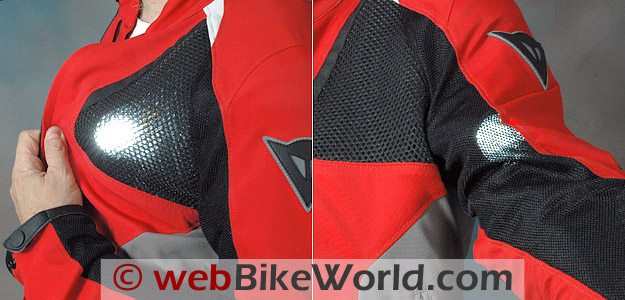
Armor and Padding
Of course, there are always compromises, and I can’t vouch for the abrasion resistance ability of the stretch fabric used in the Shotgun jacket. The jacket has no abrasion or wear protection panels on the shoulders or elbows, another reason why it has such outstanding air flow.
However, in addition to the CE-approved (Level 1) shoulder and elbow armor, the jacket can be optionally fitted with the Dainese Shield Air G1 or G2 back protector, which fits in a pocket in the back of the jacket that is accessed through a zipper at the lower part of the back on the inside.
The jacket also has a nearly full-length attachment zipper for the Dainese “Drake Air Tex” pants and I’ll definitely be looking for a pair of those next.
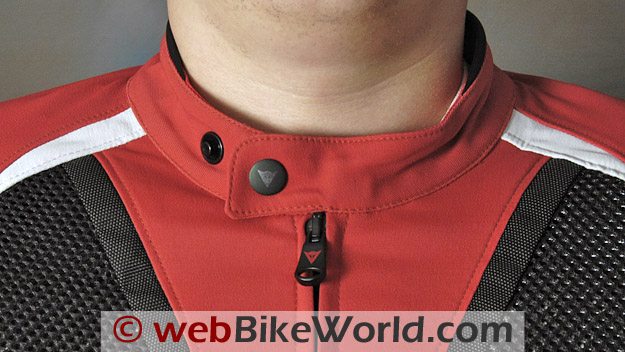
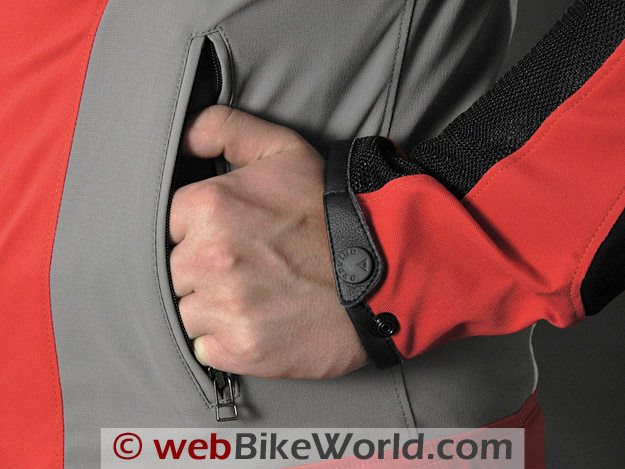
Zippers and Pockets
The Shotgun jacket is designed with two front hand pockets, covered by unbranded locking zippers. The main zipper is an “Opti” brand with what feels like an anodized metal zipper pull and runner. The inner chest pocket uses a smaller Opti brand zipper and this type is also used on the back protector pocket.
The collar secures with a two-position snap. The snap on the collar tab appears to be riveted on to the fabric and I’m not as enthusiastic about the design because the method of attachment does not appear to be as robust as other types of collar snaps.
The collar is unlined except for the stretch material and it has a thin leather piping or hem along the top. The leather hem is matched at the cuffs, which also feature a two-position snap. The snaps used on the collar and cuffs are unbranded and my honest feeling is that they are not quite up to the quality that would be provided by a Prym or other snaps I’ve used.
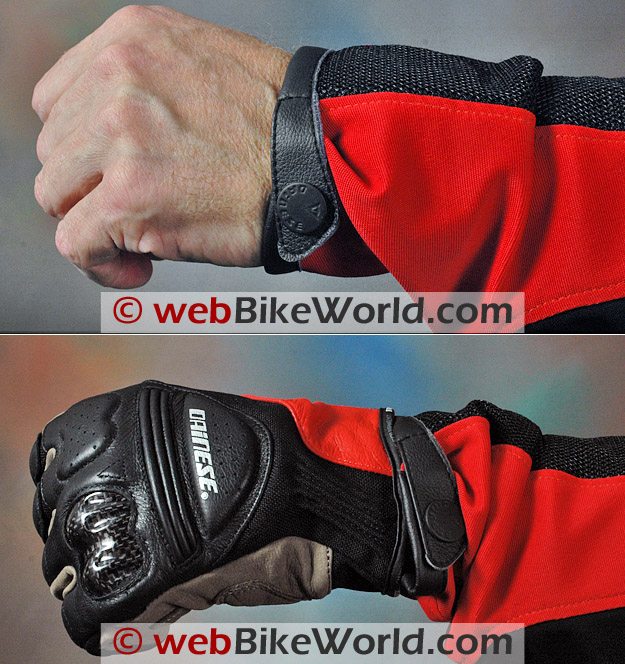
Sleeve Cuffs
The only nit I have to pick with the Shotgun jacket is in the sleeve cuff design. The two-snap cuff closure system doesn’t provide enough adjustment to tighten the cuffs to fit comfortably under a pair of short-gauntlet gloves, such as (surprisingly) the Dainese Guanto gloves we reviewed recently.
I’d rather see hook-and-loop used on the cuff or possibly a third snap, as long as it was positioned to firmly secure the cuffs so they could slide under any gloves.
As it is, the sleeve cuffs bunch up under the glove gauntlet, making for a messy appearance. But all things considered, this is a minor issue.
Conclusion
There’s no question in my mind that the Dainese Shotgun jacket provides the most air flow one could expect in a motorcycle jacket and still have a modicum of protection.
No, it’s not anywhere near as protective as, for example, the Dainese D-System D-Dry jacket we reviewed in the winter, but then again, there’s no way I could wear the D-System D-Dry jacket in 95-degree weather.
So when the going gets really, really hot and you’re tempted to strip down to a T-shirt (you wouldn’t do that, right?), reach for the Dainese Shotgun jacket for the most comfortable, stretchy air-cooled experience ever!
|
wBW Product Review: Dainese Shotgun Jacket
|
|
|---|---|
| Manufacturer: Dainese (Italy) | List Price (2010): $289.00 |
| Colors: Black/Gray, Yellow, Blue, Red, Black. | Made In: Bulgaria. |
| Sizes: 44 to 60. Women’s 40 to 52. | Star Rating (1-5): |
| Review Date: July 2010 | |
|
Note: Item was provided by a retailer, distributor or manufacturer with these Terms and Conditions.
|
|
Owner Comments and Feedback
See details on submitting comments.
From “W” (03/11): “I have also experienced the jacket flapping with wind caught once it enters the jacket. It starts to balloon a little due to the trapped wind. But otherwise it is a brilliant jacket in tropical climates where temps during the day is in the mid 30deg C.”
From “B” (8/10): “I have the Dainese jacket also and love it. My only complaint is that when I speed up to 150 km/h, the jacket causes so much buffering that I can’t even focus because of the shaking of the helmet. Below that speed though everything is great. Before you say anything, I know I shouldn’t be speeding but that’s my choice, just my 2 cents.”


